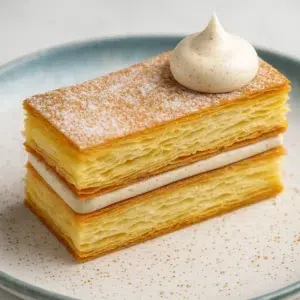
Classic Mille-Feuille – How to Make a Perfect French Napoléon Pastry at Home
Learn how to make crisp, buttery mille-feuille with silky pastry cream and flawless layers — the ultimate French dessert for special occasions.A well-made Mille-Feuille, also known as Napoleon, is a true showstopper — crisp, golden puff pastry layered with smooth, rich vanilla pastry cream. This classic French dessert is deceptively simple: just pastry and cream. But getting it right requires technique, from laminating the dough (or selecting a quality butter-based puff pastry) to mastering a thick, stable custard. This recipe walks you through every step, with tips for baking flat, flaky pastry sheets and making luscious pastry cream that won’t collapse. Whether you're celebrating something special or simply craving an elegant dessert, this mille-feuille delivers indulgence in every bite. And yes — we’ll even show you how to slice it cleanly!
Ingredients
For the Pastry Cream:
- 6 cups 1.4 L whole milk
- 1 vanilla bean split and scraped (or 1 tbsp extract / 1½ tsp paste)
- 340 g granulated sugar 1½ cups + 2 tbsp
- 90 g cornstarch 6 tbsp
- ¾ tsp kosher salt or ⅓ tsp table salt
- Yolks from 12 large eggs approx. 210 g
- 90 g unsalted butter 6 tbsp, cubed
For the Puff Pastry (Steps 1 to 97):
- 125 g water
- 8 g salt
- 165 g T45 flour fine French flour – or substitute with pastry flour
- 165 g T55 flour French all-purpose – or substitute with plain all-purpose flour
- 100 g unsalted butter for détrempe – the base dough
- 165 g extra dry butter for laminating/layering
Instructions
Make the Pastry Cream
- Heat milk with vanilla bean and seeds in a large pot to a simmer. Cover and steep 30 min.
- In a mixing bowl, whisk sugar, cornstarch, salt, and yolks until pale and smooth.
- Slowly pour in the warm milk while whisking constantly.
- Return to pot and cook over medium heat, whisking until thickened (about 7 min). Once bubbling, continue 1 min more to deactivate enzymes.
- Off heat, add butter and whisk until smooth.
- Strain through a fine-mesh sieve into a bowl. Press plastic wrap directly onto surface. Chill in ice bath for 30 min, then refrigerate 2 hours.
Prepare the Détrempe (Base Dough)
- In a bowl, mix the water, salt, and both flours. Cut the 100 g butter into small cubes and incorporate into the flour until you get a cohesive dough — do not overwork. Shape into a square, wrap in plastic, and refrigerate for at least 2 hours.
- Prepare the Beurrage (Butter Block)
- Take the extra dry butter (165 g) and flatten it between two sheets of parchment into a thin square, about 1–1.5 cm thick. Keep cold but pliable.
Lamination – Tourage
- Roll out the détrempe into a square about twice the size of the butter block.
- Place the butter in the center and fold the dough over it like an envelope.
- Roll out into a long rectangle, then give a single turn (fold into thirds).
- Chill for 30 minutes.
- Repeat this process for a total of 5 to 6 turns, chilling between each.
- 💡 Tip: Lightly flour your surface, and always brush off excess flour between folds to prevent the dough from drying out.
Rest and Roll
- After the final turn, wrap the dough and let it rest for at least 2 hours or overnight before using. Roll to desired thickness (around 2–3 mm) and cut into three rectangles measuring 20 × 11 cm.
Baking the Puff Pastry
- Dock the pastry layers all over with a fork.
- Place between two sheets of parchment, sandwiched between two baking trays.
- Add weights (like dried beans) to keep the layers flat.
- Bake at 180°C (356°F) for 35–40 minutes, removing the top tray for the last 5–10 minutes for browning.
Assembly (Once Cooled)
- Pipe or spread an even layer of pastry cream on the first layer.
- Add the second pastry layer and repeat.
Finish with the third layer.
- Dust with powdered sugar, or glaze with royal icing or fondant.
- Refrigerate 1–2 hours before slicing with a serrated knife.
Notes
mille-feuille tips to help you achieve the same result as in the image:
✅ 1. Choose Ingredients Carefully:
- Use special laminated butter (beurre de tourage or extra dry butter). It gives you well-defined layers and doesn’t melt too quickly.
- Use a mix of T45 and T55 flour (or pastry flour + all-purpose flour).
- Make sure your milk and eggs for the pastry cream are cold, and always prefer real vanilla (vanilla bean or paste).
✅ 2. Control Temperature and Rest Time:
- The dough must rest properly between each fold (tour). Chill it in the fridge for at least 30 minutes after each fold.
- Perform at least 5 folds (tours), and be precise with folding and rolling.
- When baking the layers: dock the dough thoroughly with a fork, cover it with parchment, and add a baking tray with weight (about 2 kg of dried beans) on top to keep it flat.
✅ 3. Baking the Puff Pastry:
- Bake at 180–190°C (356–374°F) for 35–40 minutes. For the last 10 minutes, remove the top tray to let it brown.
- Once baked, cool completely on a wire rack before assembling.
✅ 4. Pastry Cream (Crème Pâtissière or Mousseline):
- Cook a thick pastry cream, and make sure it boils for at least one minute to set properly.
- Once cooled, incorporate softened butter to make a smooth mousseline cream.
- The cream must be cold and firm before piping.
✅ 5. Assembly (Montage):
- Cut all puff pastry layers exactly the same size (use a hot serrated knife for clean cuts).
- Use a piping bag to pipe the cream evenly in small “kisses” or domes.
- For the top layer, press it gently without flattening the cream.
- Chill the assembled mille-feuille for 1 to 2 hours to firm up before serving.
✅ 6. Finishing Touch (Finition):
- Dust lightly with sifted powdered sugar.
- Add a simple decorative element on top
Tried this recipe?Let us know how it was!
I’m Chef Mimo, a passionate pastry chef with over 17 years of experience in the world of fine desserts. I specialize in French-style entremets, refined cakes, and creative chocolate work. Pastry is not just my profession—it’s my lifelong passion. Through PastryCrafted.com, I love sharing my recipes, techniques, and inspirations with anyone who dreams of mastering the art of pastry. Whether you’re a curious beginner or a seasoned pro, you’re welcome in my sweet world.

